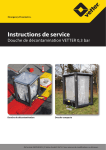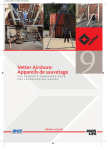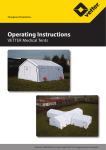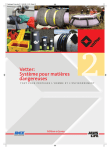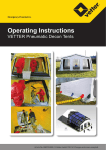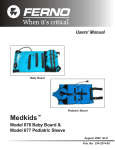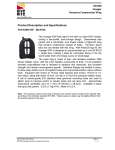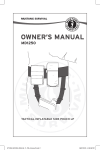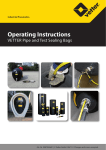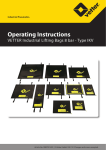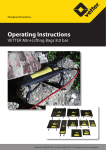Download Operating Instructions
Transcript
Emergency Pneumatics. Operating Instructions VETTER Lifting Bags 1.0 bar/14.5 psi Article No. 9987013200 | © Vetter GmbH I 01/12 I Changes and errors excepted. Vetter Lifting Bags 1.0 bar/14.5 psi Contents 1. Important preliminary remarks. . . . . . . . . . . . . . . . . . . . . . . . . . . . . . . . . . . . 2 2. Description of the product. . . . . . . . . . . . . . . . . . . . . . . . . . . . . . . . . . . . . . . . 2 2.1 Scope of delivery. . . . . . . . . . . . . . . . . . . . . . . . . . . . . . . . . . . . . . . . . . . 2 2.2 Additional accessories. . . . . . . . . . . . . . . . . . . . . . . . . . . . . . . . . . . . . . 2 2.3 Application area. . . . . . . . . . . . . . . . . . . . . . . . . . . . . . . . . . . . . . . . . . . . 3 2.4 The VETTER construction. . . . . . . . . . . . . . . . . . . . . . . . . . . . . . . . . . . . 3 2.5 Correct handling and usage. . . . . . . . . . . . . . . . . . . . . . . . . . . . . . . . . 5 2.6 Safety instructions. . . . . . . . . . . . . . . . . . . . . . . . . . . . . . . . . . . . . . . . . . 6 3. Preparing the product for use. . . . . . . . . . . . . . . . . . . . . . . . . . . . . . . . . . . . . 7 3.1 Preparations for operation. . . . . . . . . . . . . . . . . . . . . . . . . . . . . . . . . . 7 3.2 Application instructions. . . . . . . . . . . . . . . . . . . . . . . . . . . . . . . . . . . . . 7 4. Operating Instructions. . . . . . . . . . . . . . . . . . . . . . . . . . . . . . . . . . . . . . . . . . . . 8 4.1 Operation with compressed air bottle 200 bar or 300 bar. . . . . 8 4.2 Operation with other air supplies. . . . . . . . . . . . . . . . . . . . . . . . . . . . 9 4.3 Care and storage. . . . . . . . . . . . . . . . . . . . . . . . . . . . . . . . . . . . . . . . . . 10 4.4 Repair instructions. . . . . . . . . . . . . . . . . . . . . . . . . . . . . . . . . . . . . . . . . 10 5. Elimination of defects. . . . . . . . . . . . . . . . . . . . . . . . . . . . . . . . . . . . . . . . . . . . 10 6. Repetitive checks. . . . . . . . . . . . . . . . . . . . . . . . . . . . . . . . . . . . . . . . . . . . . . . . 11 7. Technical data . . . . . . . . . . . . . . . . . . . . . . . . . . . . . . . . . . . . . . . . . . . . . . . . . . . 12 EC Conformity Declaration. . . . . . . . . . . . . . . . . . . . . . . . . . . . . . . . . . . . . . . . . . 13 Page 1/14 1. Important preliminary remarks Only knowledge and the exact observance of this operating manual guarantee correct and reliable operation, achieve the best possible usage and ensure any claims made within the framework of the Vetter guarantee. Only a person who has been instructed in the use of Vetter Lifting Bags, using the manufacturer operating manual and the instructions from the user, is to be given the operation task. The operating instructions given here are to be regarded as part of the product and are to be kept for the complete life duration of the product. In case the product should be passed on to a successive user then the operating instructions must also be included. 2. Description of the product 2.1 Scope of delivery Inventory check: Items Description Qty. Lifting bags, of the same type and size 2 Inflation hoses, 5 m (16.4 ft.) in length 2 Dual deadman controller 1 Pressure regulator 200/300 bar 1 Packing bag 1 Set repair material 1 Operating instruction 1 Other set combinations are possible if required! 2.2 Additional accessories Pos. Article No. Description 1 1600 0105 00 Comp. air bottle 10 l / 200 bar 2 1600 0091 00 Comp. air bottle 6 l / 300 bar 3 1600 0199 00 Comp. air bottle 9 l / 300 bar 4 1600 0084 00 Dual connector 200 bar 5 1600 0091 00 Dual connector 300 bar Page 2/14 Vetter Lifting Bags 1.0 bar/14.5 psi 6 1600 0145 00 Pressure regulator 7 1600 0120 00 Adapter for compressor 2.3 Application area Due to the high pressure point load, it is frequently not possible to use winches or hydraulic lifting gear when dealing with heavy, unstable loads. In such cases the advantages of Vetter lifting bags become very much apparent: 99 Very light 99 Low pressure point loading 99 Very flat in design 99 Can be used in any position As already known, air distributes itself evenly on all sides. The ideal shape of a pressure container is spherical. With flexible pressure containers, such as the lifting bag, the top and bottom as well as sides bulge. With lifting bags this bulging, especially of the top and bottom, could damage the bag when pressed against sharp objects and the bag may become cut, punctured or abraded. Danger of damage to the pressurized walls of the bag. 2.4 The VETTER construction Bags which have a cylinder shape cannot bulge on the side because the material tensions evenly. This characteristic greatly reduces any damage to the side wall. Owing the extensive use of internal harnesses, bulging of the top and bottom is avoided. The strong, multi-layer and reinforced material avoids bag damage within the working area. The supporting material of the lifting bag is made of ARAMIDE which is a very light but tear-resistant artificial fibre. The coating of the supporting material is made of NEOPRENE which is a synthetic artificial rubber. Page 3/14 As opposed to material rubber, NEOPRENE has ideal characteristics for the lifting bag, e.g.: 99 High resistance to mineral oil and acid 99 High resistance to wear and has a long life cycle 99 Maintenance free The flexible lifting bags mould themselves to the shape of the load to be lifted as opposed to hydraulic and pneumatic lifting gear with their solid positioning plates. In connection with the very low application pressure of only 1.0 kg/cm², loads can be lifted carefully. Lifting bags, irrespective of the type, are unstable over the complete lifting distance! When using just one bag it must be positioned exactly under the load‘s centre of gravity otherwise load movement cannot be avoided. In practise, exact positioning is not possible! If the use of one bag cannot be avoided then positioning stability of the load is to be ensured. However, if two bags are used and if one bag is placed to the front part and the other bag to the rear part of the load then the centre of gravity will always be between the two bags. The basic condition for a stable, different control of both bags is the separate independent control using the corresponding dual controller. Due to this, the Lifting Bags 0.5 bar and 1.0 bar are equipped with the following: 2 Bags of the same type and size 2 Inflation hoses 5 m and 10 m long 1 Dual deadman controllers 1.0 bar/14.5 psi 1 Pressure regulator 200/300 bar (special version for US, F and J) The corresponding packing bag is included as well as 1 repair set. Lifting bags 1.0 bar/14.5 psi are subject to the requirements specified in DIN 14 152 T 1 (EN 13 731). Page 4/14 Vetter Lifting Bags 1.0 bar/14.5 psi According to DIN, lifting bags are classified as PNEUMATIC LIFTING DEVICES with the following definitions: Pneumatic lifting devices according to DIN 14 152 T 1 DIN-Description Sidewall Min. lift / kN LH 10 S Yes 10 LH 20 S Yes 20 LH 30 S Yes 30 LH 50 S Yes 50 LH 10 No 10 LH 20 No 20 The following Vetter lifting bags correspond to the listed standard types: Standard Vetter Lifting Bags 1.0 bar/14.5 psi LH 10 S 1/6 LH 20 S 1/9 LH 30 S 1/13 LH 50 S 1/23 Pneumatic lifting device or lifting bag without side wall can be supplied if required. As opposed to the old national standard DIN 14 152 T 1, the European standard DIN EN 13 731 requires the following with a controller: 5.2.4.6 When the operating device of a controller is released then it must immediately return to the „neutral „ position automatically. The so called „deadman switch“ was introduced as a compulsory fitting to meet the requirements of this standard. (Picture: Dual controller 1.0 bar with deadman switch.) 2.5 Correct handling and usage Lifting bags are mainly pneumatically (usually with air) driven rescue equipment for the rescue services (e.g. fire service) with which trapped people can be freed, paths made to carry out rescue or counter-measures etc. The lifting bags can also be used as working equipment to lift or move objects. Lifting bags meet the requirements specified in DIN EN 13 371 as well as GUV-G 9102 in the field of fire services. Further operational instructions are specified in the operating manual of the user. Page 5/14 2.6 Safety instructions The prespecified protective clothing is to be worn during the operation.National regulations connected with the lifting bag systems and their operation are to be observed. Lifting bags are only to be used with compressed air. Under no conditions are inflammable or aggressively acting gases to be used. The lifting bags must only be inflated with original Vetter fittings because these are subjected to an acceptance test by the manufacturer. The lifting bag system is to be checked before and after operation to determine whether it is in perfect condition. Never lay two or more lifting bags on top of each other. Ensure that the load does not slip. Gravitationally support loads being lifted during a continuous lifting procedure. Always pay particular attention to the stable condition of the support material during support work. The support structure must at least support the whole area of the bag and must be larger in its length and width than in its height! Attention danger of slipping! Never place metal on metal when carrying out support work Place stones, branches or similar items under the bag in order to increase ground grip when the ground is slippery (ice, snow, mud etc.). Avoid pointed loads such as grips, screws etc. Never place the bags on sharp edges or hot to red hot components. Use suitable intermediate layers and cover the whole bearing area of the bag. Protect the bag from sparks from welding or separation work. Do not additionally subject the bag to such things as hydraulic stamps, hoists, falling loads etc. Never remain under the load being lifted, and never try to grip the load from below! Remain at a safe distance! Avoid shearing effects caused by bag squeezing when deflating. Never stand in front of the load during operation, always place yourself to the side of it, because the bag can be catapulted out under unfavourable conditions. Page 6/14 Vetter Lifting Bags 1.0 bar/14.5 psi 3. Preparing the product for use 3.1 Preparations for operation Remove the set of lifting bags from the transport and unpack the packing bag. Make certain that the inflation device is ready for operation. Make certain that there is sufficient air supply available. Only perfectly working and tested lifting bag systems are to be used. The person in charge of the operation is to decide on the method and how it is to be applied from case to case within the field of his responsibility as well as observance of the operating instructions of the user. 3.2 Application instructions Move the lifting bag to a suitable position so that at least 75% of the supporting bag surface is under the load. Normally at least two bags are used of the same type and size. Position each bag near to the end of the load. If necessary use lines for drawing under the load or lower between loads which have to be pressed apart. Depending on the low operation pressure of the lifting bags, the maximum pressure point loading is only: 1,0 kg/cm² with lifting bags 1.0 bar Due to low bearing pressure, under-support for ground fixture is only necessary in exceptional cases. The load to be lifted is to be secured against slipping by suitable measures ! Before moving the lifting bag under the load it should be ensured that the side wall material is positioned between the top and bottom plates. Under no circumstances should the side wall material be between the load and top or the load and bottom during the lifting sequence. This can, under certain circumstances, cause damage to the side wall of the bag. If the movement height or the movement area is not sufficient for correct application of the lifting bag, then the required space can normally be quickly obtained by using the Vetter Mini Lifting Bag 8 bar. Page 7/14 4. Operating Instructions 4.1 Operation with compressed air bottle 200 bar or 300 bar Connect the pressure reducer to the compressed air bottle, 200 bar or 300 bar, using the tommy screw (1). Close the presser reducer (2). Open the valve on the bottle (3). The pre-pressure manometer (4) indicates the pressure in the bottle. Adjust the back pressure to approximately 2 bar with the regulation bar (5) (indication of the reduced pressure on the back pressure manometer (6)). 3 4 6 2 1 5 9 Connect the air hose of the pressure reducer via the nipple to the input coupling (7) of the controller. In doing this, press the nipple into the coupling until you feel it lock in. For additional safety: turn the brass sleeve (8) so that it is opposite the safety pin (9). 8 Open the hand wheel (3) of the pressure reducer. The lifting bag system is ready for operation. To inflate the lifting bag pull the lever (12) back, resp. slowly open the ball valve (10). Observe the manometers (11) and the load. If the required pressure is reached for lifting or if the lift height is achieved, then end the inflation sequence by releasing the switch lever or close the ball valve. The switch lever of the controller with the deadman switch will automatically go back to the zero position. 7 11 12 12 An integrated safety valve will automatically activate when the bag is unintentionally over-inflated above the maximum operating pressure (1.0 bar/14.5 psi) or when there is an increase in bag pressure due to additional loading of the bag. The activation tolerance for opening and closing of the safety valve must not exceed +/- 10%. Press the switch lever to „Deflate“ in order to deflate the bag or to lower the load. Load behaviour and lift movement must always be continuously monitored. Depending on the type, position and behaviour of the load during the lifting sequence, the lifting bags are either 99 simultaneously and evenly inflated or 99 inflated step-by-step, resp. individually. Remember to remain at a safe distance from the load! Do not stand directly in front of the lifting bags because if the positioning is incorrect the bags could be catapulted outwards. Page 8/14 Vetter Lifting Bags 1.0 bar/14.5 psi Never leave the controller and the inflation device unattended while the lifting bags are under pressure. Never disconnect the connection between bags and controller while the bags are under pressure. 4.2 Operation with other air supplies Amongst others, the set of transition pieces (Art. No.: 1600 0125 01) with the following adapters are available for operation with other air sources: 8 5 9 3 4 6 7 2 10 1 1. Truck compressed air connection, dual brake system. For tapping air out of the trailer coupling head. 2. Dummy coupling Seals off the control line of the brake system Remember! Ensure that the truck does not roll, use brake blocks! 3. Truck tyre inflation device adapter For tapping off air from the so-called tyre inflation bottle near the brake. Remember! The tyre inflation connection must be ensured by a safety valve as a standard (blow-off pressure approximately 7.5 bar)! 4. Truck tyre valve Inflation with a normal hand or foot pump as well as other air supplies for tyre inflation. 5. Truck tyre valve connection, can be clamped For extracting air for the spare tyre. 6. Adapter for the local air pressure network. 7. Adapter Construction-site compressor 8. Air supply hose, 10 m, green. 9. Air supply hose, 10 m, green, with blocking valve. 10. Case, red Page 9/14 4.3 Care and storage The lifting bag equipment is to be cleaned each time after use. Normally cleaning is made with warm water and a soap detergent. A chemical cleaning agent is not to be used under any circumstances and high pressure warm water equipment is also never to be used. Drying is made at room temperature. DIN 7716 is to be observed with any long storage periods. 4.4 Repair instructions Small cracks or cuts in the side wall material (max. 4 cm) can be quickly repaired without difficulty using the supplied repair material. See separat operating instructions. 5. Elimination of defects If a safety valve blows-off too early because a foreign body has penetrated and is lodged in, then the blow-off device is to be opened at the head of the safety valve by turning counter-clockwise so that the compressed air is able to escape. If the foreign body is not removed, then the upper part of the valve must be unscrewed with the safety valve disassembled. To do this position the tube pliers in the centre and unscrew by turning to the left. Carefully remove the valve ball and remove the foreign body. Screw the upper part of the valve tightly back and assemble the safety valve, and check to make certain that it functions perfectly. The set pressure must not be changed. If the seal or seal plate has been removed on the upper part of the valve then reliable function is not guaranteed. The safety valve is to be exchanged. If there are functional defects on the pressure reducer or controller due to icing, high humidity at low temperatures, then use a normal defrosting agent (similar to that used on cars). Page 10/14 Vetter Lifting Bags 1.0 bar/14.5 psi 6. Repetitive checks Repetitive checks are to be made on lifting bag systems as follows: 99 Testing during acceptance Check to ensure that all items are present and complete; this is made by the person commissioned for the task. A visual and function test is to be made by an instructed person according to the operating instructions. 99 A visual and function test is to be made after each period of use / application and carried out by an instructed person. This test is to be documented. 99 The lifting bag system is to undergo a visual test and function test at least once each year by a trained person and is to be made according to the check list in the following pages. This test is to be documented. 99 Every 5 years, or if there is any doubt about the safety or reliability, the lifting bag is to be tested according to GUV-G 9102 (formally GUV 67.13) by the manufacturer. The responsibility for the correct and professional execution of the repetitive test lies with the user! Lifting bags or lifting bag systems are not subject to the requirements specified in EC Guidelines 97/123/EC (refer to Section 3.15). A repetitive test by a specialist (e.g. TÜV or DEKRA) is no longer necessary. Page 11/14 7. Technical data Lifting bag 1.0 bar/14.5 psi Type 1/23 1/13 1/9 1/6 DIN Nomination LH 50 S LH 30 S LH 20 S LH 10 S Lifting power to/US tons 11.3/12.45 6.5/7.15 4.5/4.95 3.0/3.3 Lifting power set to/US tons 22.6/24.9 13.0/14.3 9.0/9.9 6.0/6.6 Lifting height, max. cm/inch 110/43 62/24 60/24 45/18 Insertion height (uninflated) cm/inch 3/1.2 3/1.2 3/1.2 3/1.2 Diameter cm/inch 120/47 91/36 76/30 61/24 Working pressure bar/psi 1.0/14.5 1.0/14.5 1.0/14.5 1.0/14.5 Test pressure bar/psi 1.5/21.75 1.5/21.75 1.5/21.75 1.5/21.75 Air requirement at 1.0 bar l/cu.ft. 2,486/88 806/28 544/19 262/9 Nominal content l/cu.ft. 1,243/44 403/14 272/9.6 131/4.6 Inflation time, approx. sec. 191 62 42 20 Weight, approx. kg/lbs 21/46 12/26 9/20 7/15 Weight (set), approx. kg/lbs 58/128 40/88 32/71 25/55 Rescue Set Lifting power to/US tons Lifting height cm/inch 65/26 Working pressure bar 1.0 psi 14.5 bar 1.5 psi 21.75 Air requirement at 1.0 bar l 2,164 cu.ft. 76.39 Nominal content l 1,082 cu.ft. 38.19 cm 110 x 72 x 30 inch 43 x 28 x 12 Inflation time sec. 164 Weight, approx. kg/lbs 25.0/55.1 Test pressure Packaged size 12.1/13.3 All rights reserved for technical changes within the scope of product improvement. Page 12/14 Vetter Lifting Bags 1.0 bar/14.5 psi EC Conformity Declaration in accordance with Directive 2006/42/EC Manufacturer name and address: Vetter GmbH A Unit of IDEX Corporation Blatzheimer Str. 10 - 12 53909 Zülpich We hereby declare, that the VETTER Lifting Bags 1.0 bar/14.5 psi for lifting and lowering loads Type: ______________ Serial No.: ______________ Model:______________ (see appliance plate, to be entered by customer) meets the following relevant provisions: Directive 2006/42/EC on Machinery Applied harmonised standards, references to which have been published in the Official Journal of the European Union: DIN EN ISO 12100 EN 13731 Applied national standards and technical specifications: Authorised representative for the compilation of technical documents: Vetter GmbH A Unit of IDEX Corporation Blatzheimer Str. 10 - 12 53909 Zülpich This EC Conformity Declaration was issued: Zülpich, 10.01.12 (Place, Date, Signature) Page 13/14 (Identification of signatory) Place your trust in emergency pneumatics! We are the company who can help you, find a solution to your problem! Vetter GmbH A Unit of IDEX Corporation Sales Germany International sales Blatzheimer Str. 10 - 12 D-53909 Zülpich Germany Tel.: +49 (0) 22 52 / 30 08-50 Fax: +49 (0) 22 52 / 30 08-70 Mail: [email protected] Tel.: +49 (0) 22 52 / 30 08-60 Fax: +49 (0) 22 52 / 30 08-71 Mail: [email protected] www.vetter.de Article No. 9987013200 | © Vetter GmbH I 01/12 I Changes and errors excepted. I Made in Germany















